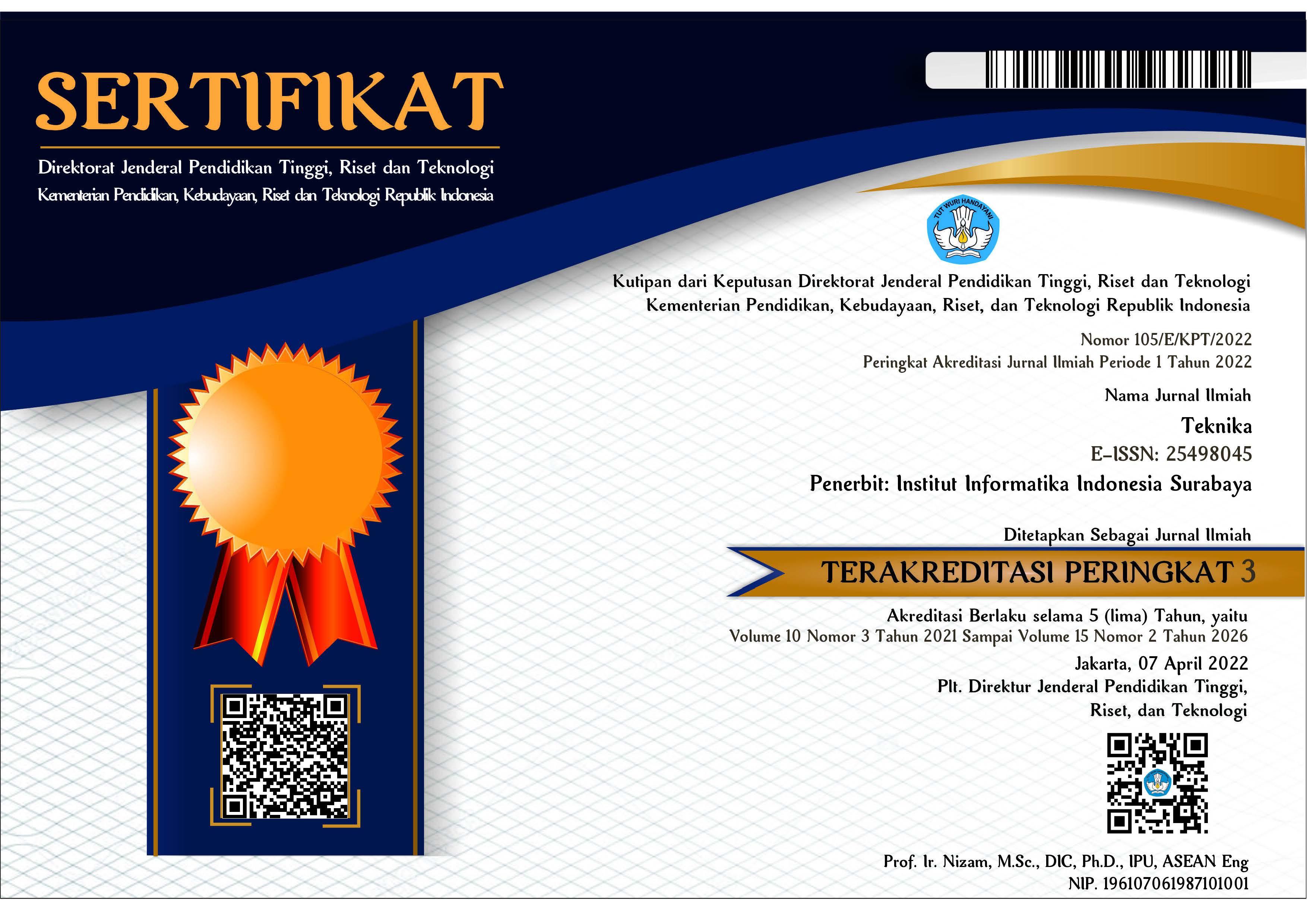Analisis Technology Readiness and Acceptance Model (TRAM) Pada Penggunaan Sport Wearable Technology
DOI:
https://doi.org/10.34148/teknika.v10i1.330Keywords:
Technology Acceptance Model, Technology Readiness, Technology Readiness and Acceptance Model, Sports Wearable TechnologyAbstract
Pertumbuhan teknologi informasi tidak dapat dihindari terutama dalam mempengaruhi kehidupan sosial manusia saat ini. Inovasi yang dikembangkan secara tidak langsung memberikan dampak positif bagi kehidupan manusia saat ini. Wearable technology adalah salah satu teknologi yang tidak hanya memberikan banyak manfaat bagi kehidupan manusia, namun sangat membantu dalam menunjang aktivitas olahraga dan kesehatan. Wearable technology merupakan suatu teknologi komputer yang terhubung dengan koneksi internet, memiliki bentuk berupa aksesoris manusia sehari-hari yang dapat dikenakan pada tubuh mereka untuk memudahkannya dalam menerima notifikasi yang sudah terhubung dengan perangkat pintar lainnya. Pada penelitian ini akan melakukan identifkasi beberapa faktor yang mempengaruhi sudut pandang pengguna pada sports wearable technology serta untuk menginvestigasi penyebab pengadopsian konsumen pada teknologi tersebut berdasarkan teori Technology Readiness and Acceptance Model (TRAM). Penelitian ini menggunakan pendekatan kuantitatif dan variabel yang akan digunakan dalam penelitian ini adalah Positive Technology Readiness, Negative Readiness, Perceived Usefulness, Perceived Ease of Use, dan Intention to Use yang merupakan teori gabungan antara Technology Readiness and Acceptance Model (TRAM) untuk menjelaskan fenomena para pengguna terhadap penggunaan sports wearable sebagai fitness tracker mereka. Penelitian menggunakan komponen berbasis SEM dan kemudian dilakukan analisis menggunakan Partial Least Square. Penelitian ini menemukan bahwa pengguna memiliki penilaian positif (positive technology readiness) yang tinggi pada sports wearable technology melalui faktor Perceived Ease of Use (PEOU) dibandingkan dengan nilai Perceived Usefulness (PU) dalam wearable technology tersebut.
Downloads
References
Baller, S., Dutta, S. & Lanvin, B. (2016). The Global Information Technology Report 2016 Innovating in the Digital Economy. World Economic Forum, Geneva.
International Data Corporation. (2019). IDC Forecasts Steady Double-Digit Growth for Wearables as New Capabilities and Use Cases Expand the Market Opportunities. Diakses dari: https://www.idc.com/getdoc.jsp?containerId=prUS44930019.
Kumar, S. (2017). Technological And Business Perspective Of Wearable Technology. Centrial University of Applied Sciences.
Haghi, M., Thurow, K. & Stoll, R. (2017). Wearable Devices in Medical Internet of Things: Scientific Research and Commercially Available Devices. Healthcare Informatics Research, Vol. 23(1), pp. 4-15. https://doi.org/10.4258/hir.2017.23.1.4.
Rodgers, M.M., Alon, G., Pai, V.M. & Conroy, R.S. (2019). Wearable Technologies for Active Living and Rehabilitation: Current Research Challenges and Future Opportunities. Journal of Rehabilitation and Assistive Technologies Engineering, Vol. 6, pp. 1-9. https://doi.org/10.1177/2055668319839607.
Lunney, A., Cunningham, N.R. & Eastin, M.S. (2016).Wearable Fitness Technology: a Structural Investigation Into Acceptance and Perceived Fitness Outcomes. Computers in Human Behavior, Vol. 65, pp. 114-120. https://doi.org/10.1016/j.chb.2016.08.007.
Kim, T. & Chiu, W. (2019). Consumer Acceptance of Sports Wearable Technology: the Role of Technology Readiness. International Journal of Sports Marketing and Sponsorship, Vol. 20(1), pp. 109-126. https://doi.org/10.1108/IJSMS-06-2017-0050.
Henriksen, A., Mikalsen, M.H., Woldaregay, A.Z., Muzny, M., Hartvigsen, G., Hopstock, L.A. & Grimsgaard, S. (2018). Using Fitness Trackers and Smartwatches to Measure Physical Activity in Research: Analysis of Consumer Wrist-worn Wearables. Journal of Medical Internet Research, Vol. 20(3). https://doi.org/10.2196/jmir.9157.
Jakicic, J.M., Davis, K.K., Rogers, R.J., King, W.C., Marcus, M.D., Helsel, D., Rickman, A.D., Wahed, A.S. & Belle, S.H. (2016). Effect of Wearable Technology Combined with a Lifestyle Intervention on Long-term Weight Loss: The IDEA Randomized Clinical Trial. JAMA - Journal of the American Medical Association, Vol. 316(11), pp. 1161-1171. https://doi.org/10.1001/jama.2016.12858
NHCS. (2018). Not Just A Fancy Fitness Tracker Wearable Sensors Help Predict Heart Problems. National Heart Centre Singapore, Vol. 2.
We Are Social & Hootsuite. (2020). Digital data Indonesia 2020. Diakses dari: https://datareportal.com/reports/digital-2020-global-digital-overview.
CNN. (2020). Pengguna Internet Kala WFH Corona Meningkat 40 Persen di RI. Diakses dari: https://www.cnnindonesia.com/teknologi/20200408124947-213-491594/pengguna-internet-kala-wfh-corona-meningkat-40-persen-di-ri.
Intelligence, I. A. (2018). Who are the World’s Biggest Wearable Tech Buyers? Diakses dari: https://www.ipsos.com/it-it/who-are-worlds-biggest-wearable-tech-buyers.
Statista. (2020). Fitness - Indonesia (Core country: data based on indepth analysis). Statista.Com.
Gartner. (2016). Gartner Survei Shows Wearable Devices Need to Be More Useful.
Lee, J., Kim, D., Ryoo, H.Y. & Shin, B.S. (2016). Sustainable Wearables: Wearable Technology for Enhancing the Quality of Human Life. Sustainability, Vol. 8(5). https://doi.org/10.3390/su8050466.
Lai, P. (2017). The Literature Review of Technology Adoption Models and Theories for the Novelty Technology. Journal of Information Systems and Technology Management. https://doi.org/10.4301/s1807-17752017000100002
Oh, J.C., Yoon, S.J. & Chung, N. (2014). The Role of Technology Readiness in Consumers’ Adoption of Mobile Internet Services Between South Korea and China. International Journal of Mobile Communications, Vol. 12(3). https://doi.org/10.1504/IJMC.2014.061460
Venkatesh, V., Morris, M., Davis, G. & Davis, F. (2003). Technology Acceptance Model - Research. MIS Quarterly.
Lin, C.H., Shin, H.Y. & Sher, P.J. (2010). Integrating Technology Readiness into Technology Acceptance: The TRAM Model. Psychology & Marketing.
Perugini, M. & Bagozzi, R. P. (2001). The Role of Desires and Anticipated Emotions in Goal-directed Behaviours: Broadening and Deepening the Theory of Planned Behaviour. British Journal of Social Psychology, Vol. 40, pp. 79-98. https://doi.org/10.1348/014466601164704
Lee, R. & Bhattacherjee, A. (2011). A Theoretical Framework for Strategic Use of the Web Among Nonprofit Organizations, SAIS 2011 Proceedings.
Godoe, P. & Johansen, T.S. (2012). Understanding Adoption of New Technologies: Technology Readiness and Technology Acceptance as an Integrated Concept. Journal of European Psychology Students, Vol. 3(1), pp. 38-52. https://doi.org/10.5334/jeps.aq
Sugiyono. (2012). Metode Penelitian Kuantitatif, Kualitatif dan R & D. Bandung: Alfabeta. https://doi.org/10.1017/CBO9781107415324.004
Creswell, J.W. & Creswell, J.D. (2018). Research and Design Qualitative, Quantitative and Mixed Methods Approaches. Thousand Oaks California.
Malhotra, N.K. (2007). Marketing Research: An Applied Orientation, 5th Edition. New Jersey, USA: Prentice-Hall, Inc.
Kline, R.B. (2015). Principles and Practice of Structural Equation Modelling (4th ed.). Methodology in the Social Sciences.
Ghozali & Latan. (2015). Partial Least Square SEM (PLS - SEM).
Wolf, C. (2005). Methodological Aspects in Cross-National Research.























